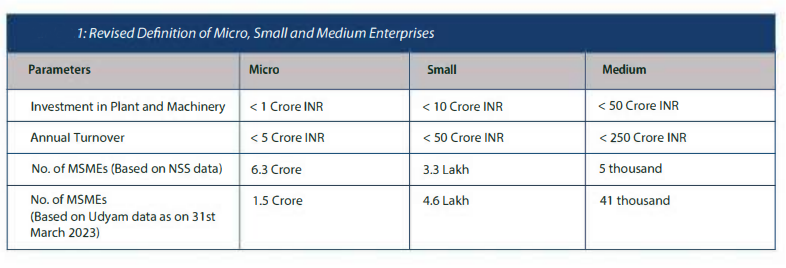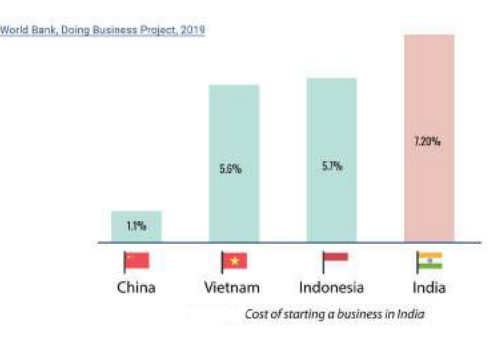Indian Economy
Boosting Exports from MSMEs: NITI Aayog
- 20 Mar 2024
- 11 min read
For Prelims: Boosting Exports from MSMEs: NITI Aayog, Exporter on Record (EOR) and Seller on Record (SOR), Rising and Accelerating MSME Performance (RAMP) Scheme.
For Mains: Boosting Exports from MSMEs: NITI Aayog, Indian Economy and issues relating to planning, mobilisation of resources, growth, development and employment.
Why in News?
Recently, the NITI Aayog released a report titled Boosting Exports from MSMEs, which recommends that the government must make it easier for smaller firms to export their goods through e-commerce platforms.
What are the Key Recommendations of the Report?
- Single Information Portal for Exporters:
- Niti Aayog recommends the creation of a single information portal for exporters, leveraging AI-based interfaces to provide comprehensive and up-to-date information on market tariffs, paperwork requirements, finance sources, service providers, incentives, and potential customers.
- It recommended establishing a comprehensive National Trade Portal (NTN) to streamline the export process for MSMEs, facilitating seamless operations and competitive advantage.
- Niti Aayog recommends the creation of a single information portal for exporters, leveraging AI-based interfaces to provide comprehensive and up-to-date information on market tariffs, paperwork requirements, finance sources, service providers, incentives, and potential customers.
- Annual Financial Reconciliation Process:
- The report suggests introducing an annual financial reconciliation process for e-commerce exporters and exemptions on import duties for rejects or returns. It also proposes creating a green channel clearance for e-commerce exports.
- Distinction Between Exporter on Record (EOR) and Seller on Record (SOR):
- To boost e-commerce exports, the report suggests distinguishing between EOR and SOR and allowing a reduction in invoice value without a percentage ceiling for all e-commerce exports.
- EOR refers to the party or entity that is officially recognised as the exporter of goods in an international transaction. The EOR is responsible for complying with all export regulations, documentation, and customs requirements of the exporting country.
- SOR refers to the party or entity that is legally recognised as the seller in a commercial transaction. The SOR is responsible for selling the goods to the buyer and may handle tasks such as negotiating the terms of sale, preparing invoices, arranging for shipping and delivery, and ensuring that the goods meet the agreed-upon specifications.
- To boost e-commerce exports, the report suggests distinguishing between EOR and SOR and allowing a reduction in invoice value without a percentage ceiling for all e-commerce exports.
- Promotion of Export Credit Guarantee:
- Access to finance is highlighted as a significant bottleneck for MSMEs. The report recommends promoting the Export Credit Guarantee to improve working capital availability, suggesting that the government create an incentive package to increase uptake from the current 10% to 50% or more.
- Easing Merchandise Exports for MSMEs:
- Suggestions include the relaxation of compliance requirements for MSMEs for a limited period and implementing a time-bound disbursement process for incentives to prevent the blocking of working capital.
- Identification of Export Opportunities in Specific Sectors:
- The report identifies various sectors where Indian MSMEs can compete in export markets, such as handicrafts, handloom textiles, ayurveda, herbal supplements, leather goods, imitation jewellery, and wooden products. It emphasises the substantial global market potential exceeding USD 340 billion for these sectors.
What is the Current Scenario of the MSME Sector in India?
- MSME Contribution to the Economy:
- The report highlights the significant contribution of MSMEs to India's economy, accounting for over 11 crore jobs and around 27% of GDP (Gross Domestic Product).
- Rapid Growth in MSME Establishment:
- Between the financial year (FY) 2019 and FY 2021, India saw a significant increase in the establishment of new MSME units, with around 40 lakh new MSMEs being established. This growth is particularly notable in micro-enterprises.
- Currently, around 38% of the total 54 lakh MSME units are engaged in manufacturing, with small and medium enterprises largely contributing to manufacturing activity suitable for export.
- The top five states with the highest concentration of manufacturing MSMEs are Uttar Pradesh, Maharashtra, Tamil Nadu, Karnataka, and Gujarat.
- Export Potential:
- Exporting is crucial for Indian MSMEs to unlock growth potential. However, India's share of global exports of low-skilled manufacturing products is only 5%, despite having a large working-age population and significant employment in manufacturing MSMEs.
- Despite the potential for exporting, only a small percentage of MSMEs engage in it, with many having annual turnover from exports of less than Rs 1 crore.
- Exporting is crucial for Indian MSMEs to unlock growth potential. However, India's share of global exports of low-skilled manufacturing products is only 5%, despite having a large working-age population and significant employment in manufacturing MSMEs.
What is MSME?
- MSMEs form the backbone of the Indian economy, contributing significantly to employment generation, industrial production, and overall economic growth.
- These enterprises are engaged in the production, manufacturing, processing, or preservation of goods and commodities.
- They account for 38.4% of the total manufacturing output and contribute 45.03% of the country's total exports.
What are the Current Challenges Related to the MSME Sector in India?
- Financial Constraint:
- In the Indian economy, access to finance has always been an issue for smaller firms and businesses. This is a major hindrance for businesses as well as the MSME sector.
- However, the most disturbing fact about it is that only 16% of SMEs get access to timely finance, resulting in small and medium firms being forced to rely on their resources.
- Lack of Innovation:
- Indian MSMEs lack innovation, and the majority of the products that they produce are based on outdated technologies. There is a severe lack of entrepreneurs in this sector, which has prevented it from adopting new technologies and tools.
- Consequently, MSMEs have faced challenges stemming from outdated technology and lower productivity levels, particularly in comparison to larger firms.
- Majority of Small Firms:
- Micro and small businesses account for more than 80% of MSMEs. Therefore, due to communication gaps and awareness, they cannot take advantage of the government's emergency line of credit, stressed asset relief, equity participation, and fund of funds operation.
- Lack of Formalisation amongst MSMEs:
- MSMEs lack formalisation and this contributes to the credit gap.
- Almost 86% of manufacturing MSMEs in the country are unregistered. Even today, only about 1.1 crore MSMEs are registered with the Goods and Services Tax.
What are the Government Initiatives Related to MSMEs?
- Raising and Accelerating MSME Performance (RAMP) Scheme
- Credit Guarantee Trust Fund for Micro & Small Enterprises (CGTMSE)
- Interest Subsidy Eligibility Certificate (ISEC)
- A Scheme for Promoting Innovation, Rural Industry & Entrepreneurship (ASPIRE)
- Credit Linked Capital Subsidy for Technology Upgradation (CLCSS)
- Zero Defect & Zero Effect (ZED)
Conclusion
- While the MSME sector in India is vital for employment generation and economic growth, there are challenges such as limited export participation and regulatory constraints that need to be addressed to unlock its full potential.
UPSC Civil Services Examination, Previous Year Question:(PYQ)
Prelims:
Q.1 What is/are the recent policy initiative(s)of Government of India to promote the growth of the manufacturing sector? (2012)
- Setting up of National Investment and Manufacturing Zones
- Providing the benefit of ‘single window clearance’
- Establishing the Technology Acquisition and Development Fund
Select the correct answer using the codes given below:
(a) 1 only
(b) 2 and 3 only
(c) 1 and 3 only
(d) 1, 2 and 3
Ans: (d)
Q.2. Which of the following can aid in furthering the Government’s objective of inclusive growth? (2011)
- Promoting Self-Help Groups
- Promoting Micro, Small and Medium Enterprises
- Implementing the Right to Education Act
Select the correct answer using the codes given below:
(a) 1 only
(b) 1 and 2 only
(c) 2 and 3 only
(d) 1, 2 and 3
Ans: (d)
Q3. Consider the following statements with reference to India : (2023)
- According to the ‘Micro, Small and Medium Enterprises Development (MSMED) Act, 2006, the ‘medium enterprises’ are those with investments in plant and machinery between `15 crore and `25 crore.
- All bank loans to the Micro, Small and Medium Enterprises qualify under the priority sector.
Which of the statements given above is/are correct?
(a) 1 only
(b) 2 only
(c) Both 1 and 2
(d) Neither 1 nor 2
Ans: (b)
Mains
Q.1 “Industrial growth rate has lagged behind in the overall growth of Gross-Domestic-Product(GDP) in the post-reform period” Give reasons. How far are the recent changes in Industrial Policy capable of increasing the industrial growth rate? (2017)
Q.2 Normally countries shift from agriculture to industry and then later to services, but India shifted directly from agriculture to services. What are the reasons for the huge growth of services vis-a-vis the industry in the country? Can India become a developed country without a strong industrial base? (2014)






